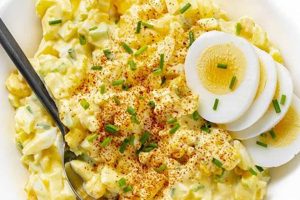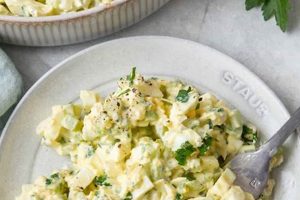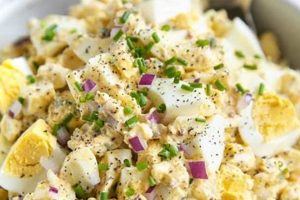Combinations of chopped hard-boiled eggs, mayonnaise, and seasonings nestled between slices of bread represent a classic comfort food. Variations often incorporate ingredients like mustard, celery, onion, relish, or spices to create unique flavor profiles. A simple recipe might involve mashing cooked eggs with mayonnaise, salt, and pepper, while more complex versions can include a variety of herbs, spices, and other textural elements. Examples include adding chopped chives and Dijon mustard for a tangy twist, or incorporating diced celery and red onion for added crunch.
These versatile sandwiches offer a convenient and affordable meal option. They can be enjoyed as a quick lunch, a light dinner, or part of a picnic spread. Historically, they emerged as a popular way to utilize leftover eggs, reflecting resourcefulness and practicality in cooking. Their enduring popularity is a testament to their simple elegance and adaptable nature, allowing for customization to suit individual preferences. Furthermore, they provide a good source of protein and other nutrients.
This discussion will further explore the nuances of crafting delectable variations, including classic recipes, innovative combinations, and tips for achieving optimal texture and flavor. Topics covered will include the selection of ingredients, preparation techniques, presentation suggestions, and storage recommendations.
Tips for Perfect Egg Salad Sandwiches
Achieving optimal flavor and texture requires attention to detail throughout the preparation process. The following tips offer guidance for elevating sandwich quality.
Tip 1: Egg Cooking Technique: Perfectly cooked eggs are essential. Overcooked yolks can result in a dry, crumbly texture. A recommended method involves placing eggs in a saucepan, covering them with cold water, bringing the water to a boil, then removing the pan from heat and letting the eggs sit in the hot water for 10-12 minutes, depending on size. Immediately transferring the eggs to an ice bath stops the cooking process and ensures easy peeling.
Tip 2: Mayonnaise Selection: The quality of mayonnaise significantly impacts the overall flavor. Experimenting with different brands and types, such as olive oil-based mayonnaise, can add depth and complexity.
Tip 3: Ingredient Ratios: Balancing the ratio of eggs to mayonnaise is crucial for achieving desired consistency. Too much mayonnaise can result in a soggy sandwich, while too little can make it dry. Start with a smaller amount of mayonnaise and add more gradually until the desired texture is reached.
Tip 4: Seasoning: Seasoning beyond salt and pepper can elevate the flavor profile. Consider incorporating Dijon mustard, paprika, garlic powder, or a dash of hot sauce.
Tip 5: Fresh Ingredients: Using fresh, high-quality ingredients enhances the overall taste. Opt for fresh herbs, crisp celery, and finely chopped onions whenever possible.
Tip 6: Bread Choice: The bread serves as the foundation of the sandwich. A sturdy bread that can hold up to the filling is recommended. Consider options such as sourdough, whole wheat, or a classic white bread.
Tip 7: Chilling Time: Allowing the egg salad to chill in the refrigerator for at least 30 minutes allows the flavors to meld and enhances the overall taste experience.
By following these tips, one can consistently create flavorful and satisfying sandwiches. Attention to these details ensures a superior culinary outcome.
This discussion now transitions to exploring variations on this classic recipe, showcasing its versatility and adaptability.
1. Classic Preparation
Classic preparation methods form the foundation for understanding and appreciating the nuances of egg salad sandwich recipes. These established techniques provide a framework for building flavor and achieving desired textures, offering a benchmark against which variations can be developed and appreciated. A deep dive into these core components illuminates the essential elements that contribute to a successful outcome.
- Hard-Boiled Eggs
Properly cooked eggs are paramount. Overcooking leads to dry, crumbly yolks, while undercooking results in a less desirable texture. Classic methods involve simmering eggs for a precise amount of time, followed by an immediate ice bath to halt the cooking process. This ensures a firm yet moist yolk, ideal for mashing and incorporating with other ingredients. The consistency of the yolk directly impacts the final texture of the egg salad.
- Mayonnaise Base
Mayonnaise serves as the binding agent and contributes richness and creaminess. Classic preparations typically utilize a standard mayonnaise, though variations with different oil bases or added flavors are possible. The amount of mayonnaise used influences the overall moisture content and texture of the salad, ranging from a light and fluffy consistency to a denser, richer mixture. Balancing the mayonnaise with other ingredients is crucial for achieving the desired consistency.
- Seasoning
Seasoning is fundamental to enhancing the natural flavors of the eggs and mayonnaise. Classic recipes often incorporate salt and pepper as the base, providing a balanced savory profile. Additional seasonings, such as mustard, paprika, or dill, can be introduced to add complexity and depth of flavor, reflecting regional preferences or individual tastes.
- Textural Elements
Incorporating textural elements provides contrast and elevates the sensory experience. Finely chopped celery is a common addition in classic preparations, contributing a subtle crunch. Other options include finely diced red onion or chives, providing both textural and flavor enhancements. These additions prevent the egg salad from becoming monotonous and offer a more dynamic mouthfeel.
By mastering these classic preparation elements, a solid foundation is established for crafting exceptional egg salad sandwiches. These core techniques allow for exploration and experimentation with variations, ensuring a consistently satisfying and flavorful outcome. Understanding the interplay of these components is crucial for achieving a balanced and delicious final product.
2. Ingredient Variations
Ingredient variations represent a pivotal aspect of egg salad sandwich recipes, offering a pathway to diverse flavor profiles and catering to individual preferences. The adaptability of the base recipe allows for a wide range of additions, transforming a simple dish into a culinary canvas for creativity. These variations impact not only the taste but also the texture and overall sensory experience. Understanding the interplay of different ingredients is crucial for crafting a well-balanced and satisfying sandwich. For example, the addition of crisp ingredients like diced celery or water chestnuts contrasts with the creamy base, while incorporating flavorful elements such as chopped fresh herbs or spices introduces complexity and depth. The choice of ingredients can also reflect regional influences or dietary preferences, allowing for personalized interpretations of this classic dish.
Specific examples illustrate the transformative power of ingredient variations. A classic American-style egg salad often incorporates sweet pickle relish, providing a tangy sweetness. Indian-inspired variations might include curry powder and chopped cilantro, introducing a warm, aromatic dimension. A Mediterranean approach could involve Kalamata olives, feta cheese, and oregano, reflecting the region’s vibrant flavors. These examples highlight how ingredient variations can transport a simple egg salad sandwich to different culinary landscapes. Furthermore, variations can cater to dietary restrictions or preferences. Substituting mayonnaise with Greek yogurt or avocado creates a healthier alternative, while incorporating ingredients like roasted red peppers or sun-dried tomatoes offers a vegan option.
In conclusion, ingredient variations are essential for maximizing the potential of egg salad sandwich recipes. They provide a mechanism for personalization, culinary exploration, and dietary adaptation. By understanding the impact of different ingredients on flavor, texture, and overall experience, one can elevate this humble dish to new heights. Careful consideration of ingredient combinations allows for the creation of unique and satisfying flavor profiles, ensuring a versatile and enjoyable culinary experience. This understanding allows for greater control over the final product, enabling the creation of egg salad sandwiches tailored to specific tastes and preferences.
3. Bread Selection
Bread selection represents a crucial element in crafting exceptional egg salad sandwiches. The bread acts as a foundation, influencing the overall structural integrity, flavor profile, and textural experience. Careful consideration of bread type is essential for achieving a harmonious balance between the filling and its carrier. Selecting the appropriate bread ensures the sandwich not only holds together but also complements the flavors and textures of the egg salad, contributing to a more satisfying culinary experience.
- Structural Integrity
The bread’s structure must withstand the moisture content of the egg salad without becoming soggy or falling apart. Dense, sturdy breads like sourdough, whole wheat, or rye provide a robust foundation, preventing structural collapse and maintaining a pleasant eating experience. Conversely, delicate breads like croissants or white bread with a loose crumb structure might be less suitable due to their susceptibility to moisture absorption.
- Flavor Pairing
The bread’s flavor should complement the egg salad rather than overpowering it. Neutral-flavored breads, such as classic white bread or challah, allow the flavors of the egg salad to shine. Alternatively, breads with more pronounced flavors, like sourdough or pumpernickel, can add complexity and depth, but careful consideration must be given to ensure the flavors harmonize rather than clash. For instance, a tangy sourdough might pair well with a Dijon mustard-based egg salad, while a sweeter brioche could complement a curried egg salad.
- Textural Contrast
The bread’s texture contributes significantly to the overall sensory experience. A crusty bread provides a satisfying contrast to the creamy egg salad, offering a textural interplay that enhances enjoyment. Soft breads, while comfortable to eat, might lack this textural contrast. Consider the desired textural profile when selecting bread, as it significantly influences the overall eating experience. A multigrain bread with a coarse texture provides a different experience than a smooth, soft white bread.
- Visual Presentation
While often overlooked, the bread’s visual appeal also plays a role. The shape, size, and color of the bread contribute to the overall presentation of the sandwich. Uniformly sliced bread creates a neat and visually appealing sandwich, while more rustic or artisanal breads can add a touch of elegance. The bread’s appearance is part of the overall dining experience, even if subconsciously.
Careful consideration of these facets of bread selection significantly impacts the final outcome of an egg salad sandwich. Selecting the right bread elevates the sandwich from merely satisfactory to truly exceptional. The interplay between the bread’s structure, flavor, texture, and visual appeal contributes to a harmonious and delightful culinary experience. Understanding these elements allows for informed decisions that maximize the potential of this classic dish. Ultimately, the bread chosen acts as a crucial supporting player to the star ingredientthe egg salad itselfcreating a harmonious and satisfying culinary experience.
4. Texture and Flavor
Texture and flavor represent integral components of successful egg salad sandwich recipes. The interplay between these two elements dictates the overall sensory experience, influencing enjoyment and satisfaction. Understanding this dynamic allows for deliberate manipulation of ingredients and techniques to achieve desired outcomes. A well-crafted egg salad sandwich exhibits a harmonious balance of textures and flavors, creating a cohesive and pleasurable culinary experience. This balance hinges on careful consideration of individual ingredients and their contribution to the final product.
The texture of egg salad derives from the interplay of several factors. Properly cooked eggs provide a foundational smoothness, while the addition of mayonnaise contributes creaminess. Incorporating textural elements like chopped celery, red onion, or pickles introduces contrasting crunch. These contrasting textures prevent monotony and create a dynamic mouthfeel. For example, a finely minced celery provides a subtle crunch, while coarsely chopped walnuts offer a more robust textural contrast. The size and shape of these additions directly influence the perceived texture of the sandwich. Furthermore, the consistency of the egg salad itself, determined by the ratio of mayonnaise to egg, plays a significant role. A higher proportion of mayonnaise results in a smoother, creamier texture, while a lower proportion yields a denser, chunkier consistency. This balance influences how the egg salad interacts with the chosen bread.
Flavor development relies on a balanced combination of ingredients. The inherent richness of the eggs and mayonnaise serves as a backdrop for additional flavors. Classic seasonings like salt, pepper, and mustard provide a foundational savory profile. Incorporating ingredients such as fresh herbs (dill, chives), spices (paprika, curry powder), or acidic elements (vinegar, lemon juice) adds depth and complexity. For instance, a touch of Dijon mustard adds a tangy complexity, while smoked paprika introduces a subtle smoky note. The interplay of these flavors creates a multi-dimensional taste experience, moving beyond the basic egg and mayonnaise profile. The choice of bread also contributes to the overall flavor profile. A sourdough bread adds a tangy note, while a whole wheat bread introduces a nutty undertone. These nuanced flavor combinations elevate the egg salad sandwich from simple to sophisticated.
Achieving a successful balance between texture and flavor requires careful consideration of ingredient selection, preparation techniques, and proportions. Overemphasis on one element at the expense of the other can result in a less satisfying outcome. A sandwich with an overly smooth texture might lack interest, while an overly assertive flavor profile can overwhelm the palate. A harmonious blend of textures and flavors, achieved through thoughtful preparation and ingredient selection, ensures a delightful and well-balanced culinary experience. Understanding the interplay of these elements allows for the creation of egg salad sandwiches tailored to individual preferences, ensuring consistent enjoyment and satisfaction.
5. Presentation and Serving
Presentation and serving significantly influence the perception and enjoyment of egg salad sandwiches. While often overlooked, these aspects contribute to the overall dining experience, impacting everything from initial visual appeal to final consumption. Thoughtful presentation elevates the dish beyond mere sustenance, transforming it into a more engaging and satisfying culinary experience. This connection between presentation and enjoyment stems from the psychological impact of visual cues on appetite and perceived value. An aesthetically pleasing presentation enhances anticipation and enjoyment, while a careless presentation can diminish the perceived quality, regardless of the taste.
Several factors contribute to effective presentation. The choice of serving platter or plate sets the stage. A simple white plate provides a neutral backdrop that allows the sandwich to take center stage. Alternatively, a rustic wooden board or a vibrant platter can add visual interest and thematic context. Garnishes further enhance the presentation. A sprinkle of paprika, a sprig of fresh parsley, or a few strategically placed cherry tomatoes add color and visual appeal. The arrangement of the sandwiches themselves also plays a role. Sliced sandwiches arranged geometrically on a platter create a sense of order and elegance, while halved or quartered sandwiches offer a more casual presentation. For example, serving halved tea sandwiches on a tiered stand elevates the presentation for a more formal occasion, while open-faced egg salad tartines offer a modern and sophisticated twist. These choices influence the diner’s perception and create different dining experiences.
Beyond aesthetics, practical considerations also govern presentation and serving. The manner in which sandwiches are cut and served influences ease of consumption. Halved or quartered sandwiches are easier to handle than whole sandwiches, particularly for larger bread sizes. Serving utensils, such as small forks or spreaders, contribute to a more refined dining experience. For picnics or casual gatherings, wrapping individual sandwiches in parchment paper or placing them in small containers enhances portability and convenience. These practical choices contribute to a smoother and more enjoyable dining experience. Ultimately, the goal of presentation and serving is to enhance enjoyment and create a positive dining experience. Whether simple or elaborate, these elements contribute to the overall perception and appreciation of egg salad sandwiches, demonstrating that even a simple dish benefits from attention to detail in its presentation.
Frequently Asked Questions
This section addresses common inquiries regarding egg salad sandwich preparation, offering concise and informative responses.
Question 1: How can one prevent overly dry egg salad?
Dryness often results from overcooked yolks or insufficient mayonnaise. Employing precise cooking times and incorporating mayonnaise gradually, while assessing consistency, prevents this issue. Adding a small amount of plain yogurt or sour cream can also enhance moisture.
Question 2: What are effective methods for enhancing flavor beyond basic seasonings?
Flavor complexity can be achieved through various additions. Incorporating Dijon mustard, chopped fresh herbs (dill, chives, tarragon), or spices like paprika or curry powder introduce nuanced flavor dimensions. Consider incorporating finely diced pickles, olives, or capers for a briny or tangy element.
Question 3: How does bread choice impact the overall quality of the sandwich?
Bread selection is crucial for structural integrity and flavor harmony. Sturdy breads, such as sourdough or whole wheat, prevent sogginess and complement the egg salad filling. Bread flavor should complement the egg salad’s flavor profile, avoiding clashes.
Question 4: What are optimal storage practices for egg salad?
Egg salad should be stored in an airtight container within a refrigerator promptly after preparation. It is best consumed within three to five days. Keeping the egg salad chilled inhibits bacterial growth and maintains optimal quality.
Question 5: Can egg salad be frozen for future consumption?
Freezing egg salad is generally not recommended. Freezing alters the texture of both the mayonnaise and eggs, resulting in a less desirable consistency upon thawing. Flavor can also be negatively affected.
Question 6: How can one adapt egg salad recipes for dietary restrictions?
Egg salad can be adapted for various dietary needs. Substituting mayonnaise with Greek yogurt or avocado creates a lower-fat and healthier option. Incorporating ingredients like roasted red peppers or mashed chickpeas offers plant-based alternatives.
Addressing these frequently asked questions provides a comprehensive understanding of essential aspects of egg salad sandwich preparation. Attention to these details ensures optimal results.
The following section will offer concluding remarks and summarize key takeaways for crafting delicious egg salad sandwiches.
Conclusion
Exploration of egg salad sandwich recipes reveals a deceptively complex culinary landscape. Emphasis on ingredient quality, precise preparation techniques, and thoughtful flavor combinations yields optimal results. Careful consideration of bread selection, textural elements, and presentation elevates this seemingly simple dish. Understanding the interplay of these factors allows for consistent creation of exceptional sandwiches. Mastery of these components provides a foundation for both classic preparations and innovative variations, adapting to individual preferences and dietary needs.
Egg salad sandwiches represent more than a convenient meal; they offer a canvas for culinary expression. Continued exploration of flavor profiles, ingredient combinations, and presentation styles expands culinary horizons. This ongoing experimentation ensures the enduring appeal and versatility of this classic dish, solidifying its position as a timeless culinary staple. From simple lunchtime fare to elegant tea sandwiches, the possibilities remain boundless.






